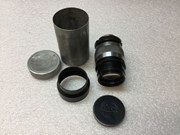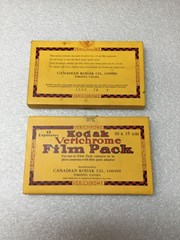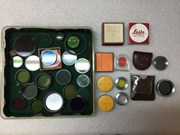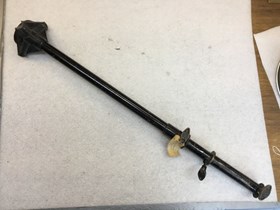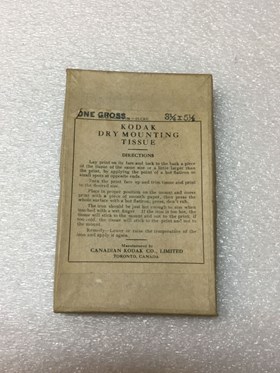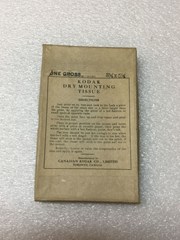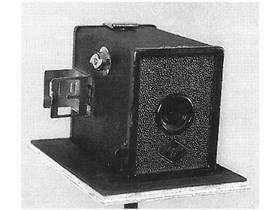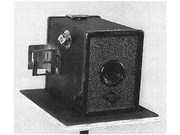Narrow Results By
- Date
- 1931 – 1942
- Material
- metal; glass;
- Catalogue Number
- 104.41.0214
- Description
- Ernst Leitz Wetzlar Hektor f=7,3 cm 1:1,9 lens with hood and lens cap in a metal tube case. The lens cap has Leica engraved on it - the case has the manufacturer name and the lens size stamped on the lid, which slides up off the tube.
1 image
- Title
- Camera Lens
- Date
- 1931 – 1942
- Material
- metal; glass;
- Dimensions
- 8.6 cm
- Description
- Ernst Leitz Wetzlar Hektor f=7,3 cm 1:1,9 lens with hood and lens cap in a metal tube case. The lens cap has Leica engraved on it - the case has the manufacturer name and the lens size stamped on the lid, which slides up off the tube.
- Credit
- Gift of Catharine Robb Whyte, O. C., Banff, 1979
- Catalogue Number
- 104.41.0214
Images
This material is presented as originally created; it may contain outdated cultural descriptions and
potentially offensive content.
Read more.
Canadian commercial postcards
https://archives.whyte.org/en/permalink/descriptions55124
- Part Of
- Luxton family fonds
- Scope & Content
- File consists of commercial postcards with images pertaining to landscapes, tourist attractions, Stoney Nakoda community members [including Leah Rider Hunter], winter sports, wildlife and other related themes within Canada. Images primarily depict scenes in Banff National Park and the Canadian Rock…
- Date Range
- [1910-1930]
- Reference Code
- LUX / I / E5 / PG - 1 to 63
- Description Level
- 5 / File
- GMD
- Published record
- Postcard
- Part Of
- Luxton family fonds
- Description Level
- 5 / File
- Fonds Number
- LUX
- Series
- LUX / I / E : Collected materials
- Sous-Fonds
- LUX / I : Norman Luxton sous-fonds
- Sub-Series
- LUX / I / E5 : Postcards
- Accession Number
- LUX
- Reference Code
- LUX / I / E5 / PG - 1 to 63
- Responsibility
- Most images in file produced by photographer Byron Harmon; some materials produced by photographers George Noble, G. & W. Fear, Rumsey & Co. Ltd, and J.C. Walker
- Date Range
- [1910-1930]
- Physical Description
- 63 b&w postcards ; 9 x 14 cm
- Scope & Content
- File consists of commercial postcards with images pertaining to landscapes, tourist attractions, Stoney Nakoda community members [including Leah Rider Hunter], winter sports, wildlife and other related themes within Canada. Images primarily depict scenes in Banff National Park and the Canadian Rockies, and also include content from Saskatchewan and British Columbia.
- Notes
- Date range for materials in file is estimate provided by Processing Archivist
- Some items are annotated with information pertaining to images on postcards [names of individuals, locations, etc.]
- Name Access
- Hunter, Leah Rider
- McDougall, David
- Subject Access
- Activities
- Aerial photography
- Animals
- Businesses
- Buildings
- Buffalo
- Bison
- Black Bears
- Communities
- Community life
- Community events
- Dogs
- Dogsledding
- Environment
- Hot Springs
- Hotels
- Indigenous Peoples
- Landscapes
- Leisure
- Mountains
- Mount Royal Hotel
- Photography
- Postcards
- Recreation
- Scenery
- Snowshoes and snowshoeing
- Sports and recreation
- Sports
- Stoney Nakoda
- Tourism
- Travel
- Winter
- Winter sports
- Geographic Access
- Canada
- Alberta
- Banff National Park
- Banff
- Saskatchewan
- Loon Lake
- British Columbia
- Fairmont
- Language
- English
- Conservation
- Some items stored in mylar
- Category
- Commerce and industry
- Cultural pluralism
- Environment
- Exploration, discovery and travel
- Indigenous Peoples
- Sports, recreation and leisure
- Title Source
- Title based on contents of file
- Processing Status
- Processed
This material is presented as originally created; it may contain outdated cultural descriptions and
potentially offensive content.
Read more.
- Date
- 1938 – 1945
- Material
- cardboard;
- Catalogue Number
- 104.41.0204 a,b
- Description
- Two boxes of 12 10x15cm Kodak Verichrome Film Packs with broken seals. Each box is mostly yellow with black and red manufacturer and product details throughout - there are two paper adhesive stickers holding the box closed, the one that has the expiration date on it on each box is broken.Verichrome…
1 image
- Title
- Film Pack
- Date
- 1938 – 1945
- Material
- cardboard;
- Dimensions
- 1.4 x 17.9 x 10.9 cm
- Description
- Two boxes of 12 10x15cm Kodak Verichrome Film Packs with broken seals. Each box is mostly yellow with black and red manufacturer and product details throughout - there are two paper adhesive stickers holding the box closed, the one that has the expiration date on it on each box is broken.Verichrome was a kind of panchromatic film that yielded high-quality black and white photographs thanks to the fine-grained emulsion. Film Packs were basic forms of storage meant to be used shortly after purchasing as their [mostly] paper packaging did not keep out oxygen well and had a tendency to fog over time, rendering the film unusable in the long term. It was replaced by the more stable Verichrome Pan in the 1950s.
- Credit
- Gift of Robert Crosby Family, Banff, 1998
- Catalogue Number
- 104.41.0204 a,b
Images
This material is presented as originally created; it may contain outdated cultural descriptions and
potentially offensive content.
Read more.
- Date
- 1930 – 1970
- Material
- plastic; fabric; felt; leather; glass; cardboard;
- Catalogue Number
- 104.41.0212
- Description
- Square clear plastic box lined with green felt containing 26 camera filters and 2 lens caps - 6 filters are in various containers, one is unopened. Most filters were manufactured by Leitz Wetzler [the company changed its name to Leica in 1986], some are Kodak, and two are Zeiss. Filters include yel…
1 image
- Title
- Filter Box
- Date
- 1930 – 1970
- Material
- plastic; fabric; felt; leather; glass; cardboard;
- Dimensions
- 3.8 x 23.2 x 23.2 cm
- Description
- Square clear plastic box lined with green felt containing 26 camera filters and 2 lens caps - 6 filters are in various containers, one is unopened. Most filters were manufactured by Leitz Wetzler [the company changed its name to Leica in 1986], some are Kodak, and two are Zeiss. Filters include yellow, orange, red, blue, tinted, and clear patterned glass.
- Credit
- Gift of Catharine Robb Whyte, O. C., Banff, 1979
- Catalogue Number
- 104.41.0212
Images
This material is presented as originally created; it may contain outdated cultural descriptions and
potentially offensive content.
Read more.
- Date
- 1930 – 1960
- Material
- metal; paper;
- Catalogue Number
- 102.05.0121 a,b
- Description
- Two heavy black-painted metal stands, possibly used to hold up flood/spotlights during photo shoots. Each stand consists of a triangular base through which it appears support crossbars would be fed and two further extensions [tightened/loosened by slim diamond-shaped knobs] can be extended from the…
1 image
- Title
- Light Stand
- Date
- 1930 – 1960
- Material
- metal; paper;
- Dimensions
- 14.5 x 12.2 x 106.0 cm
- Description
- Two heavy black-painted metal stands, possibly used to hold up flood/spotlights during photo shoots. Each stand consists of a triangular base through which it appears support crossbars would be fed and two further extensions [tightened/loosened by slim diamond-shaped knobs] can be extended from the main part of the stand. All of the knobs throughout the stand have a stylized R and M overlapping inside a circle on them, but no information as to a manufacturer could be found. One stand has a faded and warped Canadian Pacific Railway travel tag attached to it by a short length of wire - the tag displays Morant’s address on both sides.
- Credit
- Gift of Nicholas Morant, Banff, 2006
- Catalogue Number
- 102.05.0121 a,b
Images
This material is presented as originally created; it may contain outdated cultural descriptions and
potentially offensive content.
Read more.
Mounting Tissue
https://archives.whyte.org/en/permalink/artifact104.41.0205
- Date
- 1930 – 1950
- Material
- cardboard;
- Catalogue Number
- 104.41.0205
- Description
- Plain cardboard box of 3 1/4 x 5 1/3[?] Kodak Dry Mounting Tissue held closed with a long strip of paper adhesive wrapped over the lid to the bottom of the box and a paper adhesive label on the lid displaying the manufacturer and direction of use details. Dry Mounting Tissues were a kind of adhesiv…
1 image
- Title
- Mounting Tissue
- Date
- 1930 – 1950
- Material
- cardboard;
- Dimensions
- 1.7 x 10.2 x 15.0 cm
- Description
- Plain cardboard box of 3 1/4 x 5 1/3[?] Kodak Dry Mounting Tissue held closed with a long strip of paper adhesive wrapped over the lid to the bottom of the box and a paper adhesive label on the lid displaying the manufacturer and direction of use details. Dry Mounting Tissues were a kind of adhesive used to attach a print to a support or mount [like card stock, cardboard, wood, foam core, etc] that is activated by heat and pressure. A smooth piece of paper would be laid over the print, with the tissue between the print and the support, and then a hot iron would be pressed over the whole area, melting the tissue and activating the glue. Once cool, the glue was set.
- Credit
- Gift of Robert Crosby Family, Banff, 1998
- Catalogue Number
- 104.41.0205
Images
This material is presented as originally created; it may contain outdated cultural descriptions and
potentially offensive content.
Read more.
- Date
- 1939 – 1980
- Material
- metal; glass; plastic; leather; fabric
- Catalogue Number
- 105.05.0047 a-d
- Description
- A Kodaslide Projector Model 2 inside a hardshell leather case with the lens and slide carrier.a) A black slide projector body with plate on the front, below where the lens goes, that reads “KODASLIDE PROJECTOR MODEL 2” “MADE IN UNITED STATES OF AMERICA BY” “EASTMAN KODAK CO” “ROCHESTER, N.Y.” “100 …
1 image
- Title
- Slide Projector
- Date
- 1939 – 1980
- Material
- metal; glass; plastic; leather; fabric
- Dimensions
- 12.6 x 10.1 x 17.1 cm
- Description
- A Kodaslide Projector Model 2 inside a hardshell leather case with the lens and slide carrier.a) A black slide projector body with plate on the front, below where the lens goes, that reads “KODASLIDE PROJECTOR MODEL 2” “MADE IN UNITED STATES OF AMERICA BY” “EASTMAN KODAK CO” “ROCHESTER, N.Y.” “100 - 250 VOLTS A.C. OR D.C. 100 WATTS” “PAT IN U.S.A. 1,434,268 DES. 105,905 PAT. PEND.” “TRADE MARK REG. U.S. PAT. OFF”. There is venting on the top of the body for the light bulb. On either side are two small silver knobs that can be twisted out. On the left side is another larger silver knob that when turned tilts the lens and projector up a couple centimetres. Connected to the back is a long black power cord with three yellow stickers wrapped around parts of the cord. b) A long silver lens for the Kodaslide Projector with black ribbed plastic at the end where the lens is. The black end twists to retract and extend. Along the front of the lens on the black plastic text reads “MADE IN U.S.A. BY EASTMAN KODAK CO. ROCHESTER, N.Y. 5 INCH”. There is a small metal clasp near the middle. 5.5 x 5.5 x 12.0 cm.c) A silver metal slide carrier with two slots for slides. One side is flat. The other side features raised squares with a kind of frame, which is where the slides would go, and on the right side is a small metal bar that can be pushed down to create a stop when the slide carrier is in the projector. 5.2 x 0.5 x 14.8 cm.d) A black hardshell leather case with a black handle and a small silver latch close to the bottom of the case. The back side of the case features four very short metal legs for the case to stand on. The case opens with the bigger half as the top of the case. The inside is lined with brown fabric and features compartments for different parts of the projector with brown nylon straps and clasps to hold them in place while moving. Inside the lid of the case is black plate that reads “COMBINATION CASE” “FOR” “KODASLIDE PROJECTOR” “MODEL 2” “MADE IN UNITED STATES OF AMERICA BY” “EASTMAN KODAK CO.” “ROCHESTER, N.Y.” 18.0 x 27.3 x 27.6 cm.
- Credit
- Gift of Don Harmon, Banff, 1985
- Catalogue Number
- 105.05.0047 a-d
Images
This material is presented as originally created; it may contain outdated cultural descriptions and
potentially offensive content.
Read more.
- Date
- 1930 – 1980
- Material
- metal
- Catalogue Number
- 104.41.0158
- Description
- Small silver and black basic metal tripod - no manufacturer’s mark and possibly used for mounting lights. Four extensions can be released from the main [hollow] compartment via metal keys and the base legs simply fold out - no locks or braces.
1 image
- Title
- Tripod
- Date
- 1930 – 1980
- Material
- metal
- Dimensions
- 69.7 cm
- Description
- Small silver and black basic metal tripod - no manufacturer’s mark and possibly used for mounting lights. Four extensions can be released from the main [hollow] compartment via metal keys and the base legs simply fold out - no locks or braces.
- Credit
- Gift of Nicholas Morant, Banff, 2006
- Catalogue Number
- 104.41.0158
Images
This material is presented as originally created; it may contain outdated cultural descriptions and
potentially offensive content.
Read more.
Banff townsite, road trip, Luxton family home, Indigenous families
https://archives.whyte.org/en/permalink/descriptions54975
- Part Of
- Luxton family fonds
- Scope & Content
- File consists of photograph prints pertaining to attractions in and near Banff including the Animal Paddock and golfing at Banff Springs; the Luxton family home and garden and a stray dog on the Luxton property; an unidentified Indigenous couple, two individuals and a family posing near teepees [po…
- Date Range
- [1905-1908]
- [1915-1930]
- [1935-1940]
- Reference Code
- LUX / I / E4 / PA - 127 to 172
- Description Level
- 5 / File
- GMD
- Photograph
- Photograph print
- Part Of
- Luxton family fonds
- Description Level
- 5 / File
- Fonds Number
- LUX
- Series
- LUX / I / E : Collected material
- Sous-Fonds
- LUX / I : Norman Luxton sous-fonds
- Sub-Series
- LUX / I / E4 : Photographs
- Accession Number
- LUX
- Reference Code
- LUX / I / E4 / PA - 127 to 172
- Date Range
- [1905-1908]
- [1915-1930]
- [1935-1940]
- Physical Description
- 46 photographs : b&w prints; 17.5 x 12 cm or smaller
- Scope & Content
- File consists of photograph prints pertaining to attractions in and near Banff including the Animal Paddock and golfing at Banff Springs; the Luxton family home and garden and a stray dog on the Luxton property; an unidentified Indigenous couple, two individuals and a family posing near teepees [possibly members of the Stoney Nakoda tribe in Morley]; a road trip to Sinclair Canyon with Norman Luxton and friends; and various scenic views of Banff and surrounding area including Sundance Lodge.
- Notes
- Photographs are not dated - date ranges provided are estimates by Processing Archivist based on content and format of file contents
- Name Access
- Luxton, Norman
- Subject Access
- Aerial photography
- Animal Paddock
- Animals
- Dogs
- Family and personal life
- Landscapes
- Land, settlement and immigration
- Teepees
- Townsite development
- Travel
- Camping
- Public events
- Communities
- First Nations
- Indigenous Peoples
- Geographic Access
- Canada
- Alberta
- Banff
- Morley
- Banff National Park
- Language
- English
- Conservation
- Items placed in mylar
- Category
- Exploration, discovery and travel
- Family and personal life
- First nations
- Land, settlement and immigration
- Title Source
- Title based on contents of file
- Processing Status
- Processed
This material is presented as originally created; it may contain outdated cultural descriptions and
potentially offensive content.
Read more.
- Date
- 1938
- Material
- metal; glass; paper
- Catalogue Number
- 104.41.1113 a,b
- Description
- A simple black box camera with black, simulated textured leather. It also has an adhesive-taped, original box. The inverted aperture in the front has a black metal retention ring surrounding it. Below this “Agfa” is imprinted on the camera, surrounded by a diamond-shaped box. There is a black metal…
1 image
- Title
- Box Camera
- Date
- 1938
- Material
- metal; glass; paper
- Dimensions
- 8.5 x 6.5 cm
- Description
- A simple black box camera with black, simulated textured leather. It also has an adhesive-taped, original box. The inverted aperture in the front has a black metal retention ring surrounding it. Below this “Agfa” is imprinted on the camera, surrounded by a diamond-shaped box. There is a black metal rim which overlaps the edges on the front of the camera; on both sides there is a slight extension, .03 x.05 wide, 2.0cm from the top, with a hole in the metal. This fits over two small metal knobs on each side of the camera body. It appears that pushing the knobs in and pulling, would release the front part of the camera from the body. On the viewer’s left is the metal shutter release; a small metal lever that can be pulled down to release the shutter and expose the lens from inside the body. On the same side is the metal film winder, 3.0cm from the front and .50cm from the top; this is a flat piece of metal 2.0cm in diameter, with arrows indicating the direction to turn (clockwise arrows), a round raised metal tab, onto which is screwed a piece of metal (2.5cmx1.0cm wide in the middle) to wind the film. It can also be pulled out to release the metal film chamber. The metal is turned down on the side of each end so the fingers can grasp it for turning. A metal folding viewfinder is .50cm from the back and 2.7cm from top and bottom; a flat piece of metal 3.0cm sq., folded at the sides, is rivetted onto the body. Two flat metal pieces are attached at each end, one on a spring to fold down; this piece is 2.4x2.7cm wide with a window cut out .50x1.0cm wide. The other piece is 2.7cm sq. with a window of 1.5x2.4cm wide; the cutout has a piece of metal raised from the bottom of the window. The cutout is for perspective when you look through the viewfinder, vertically or horizontally. This piece of metal folds down to become the top, effectively making the viewfinder flat when not in use. There is a hinged door on the back of the camera and a cut-out metal latch on the door that connects to a small metal knob 1.0cm from the edge of the body. There is a red circle film window (1.0cm diagonally) which lets you read the frame number on the film. On the inside of the door are two rivets that connect the hinge. Above that and below the red circle, is a white painted circle with “USE AB” printed in black, overlapping a painted orange, blue, white, and yellow Agfa Plenachrome film box. The red viewfinder is 4.0cm from the base. A metal film chamber, with two metal rollers on each end for winding the film on, fits inside the camera. It can be released by pulling out the film winder. The canister is 7.0x5.0 wide, is open at one end, hollow in the centre, sloping upwards with a circular hole at the other end to let light in. There are two sprockets sitting on two cutouts on top of the canister and two on the bottom, onto which the film is winded. There are two rivets attaching two Y-shaped metal pieces, on either end that guide and let the film move and roll. The top of the camera has two metal knobs 1.5cm crosswise from each end, where a leather strap with a hole on either end, .07cm from the edge, fits in to make a diagonal strap/handle for carrying. The strap is imprinted with “A-8 CADET”. There is a small metal pull-up tab, 1.0cm from the edge of the front of the camera, that lets you time the shutter speed.
- Subject
- households
- photography
- hobbies
- Bob Louden
- Credit
- Gift of Bob Louden, Calgary, 2004
- Catalogue Number
- 104.41.1113 a,b
Images
This material is presented as originally created; it may contain outdated cultural descriptions and
potentially offensive content.
Read more.


